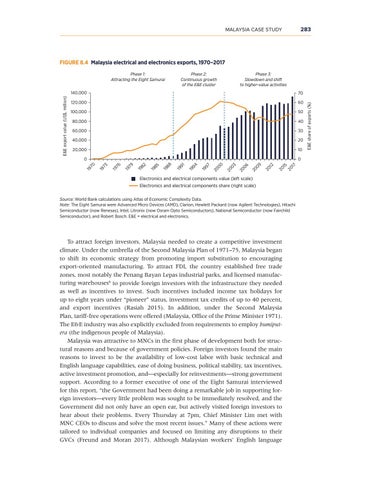MALAYSIA CASE STUDY
283
FIGURE 8.4 Malaysia electrical and electronics exports, 1970–2017 Phase 2: Continuous growth of the E&E cluster
Phase 3: Slowdown and shift to higher-value activities
140,000
70
120,000
60
100,000
50
80,000
40
60,000
30
40,000
20
20,000
10
0
15 20 17
20
12 20
09
06
20
20
03 20
97
00 20
19
94 19
91 19
88 19
85 19
82 19
79 19
76 19
73 19
19
70
0
Electronics and electrical components value (left scale) Electronics and electrical components share (right scale) Source: World Bank calculations using Atlas of Economic Complexity Data. Note: The Eight Samurai were Advanced Micro Devices (AMD), Clarion, Hewlett Packard (now Agilent Technologies), Hitachi Semiconductor (now Renesas), Intel, Litronix (now Osram Opto Semiconductors), National Semiconductor (now Fairchild Semiconductor), and Robert Bosch. E&E = electrical and electronics.
To attract foreign investors, Malaysia needed to create a competitive investment climate. Under the umbrella of the Second Malaysia Plan of 1971–75, Malaysia began to shift its economic strategy from promoting import substitution to encouraging export-oriented manufacturing. To attract FDI, the country established free trade zones, most notably the Penang Bayan Lepas industrial parks, and licensed manufacturing warehouses6 to provide foreign investors with the infrastructure they needed as well as incentives to invest. Such incentives included income tax holidays for up to eight years under “pioneer” status, investment tax credits of up to 40 percent, and export incentives (Rasiah 2015). In addition, under the Second Malaysia Plan, tariff-free operations were offered (Malaysia, Office of the Prime Minister 1971). The E&E industry was also explicitly excluded from requirements to employ bumiputera (the indigenous people of Malaysia). Malaysia was attractive to MNCs in the first phase of development both for structural reasons and because of government policies. Foreign investors found the main reasons to invest to be the availability of low-cost labor with basic technical and English language capabilities, ease of doing business, political stability, tax incentives, active investment promotion, and—especially for reinvestments—strong government support. According to a former executive of one of the Eight Samurai interviewed for this report, “the Government had been doing a remarkable job in supporting foreign investors—every little problem was sought to be immediately resolved, and the Government did not only have an open ear, but actively visited foreign investors to hear about their problems. Every Thursday at 7pm, Chief Minister Lim met with MNC CEOs to discuss and solve the most recent issues.” Many of these actions were tailored to individual companies and focused on limiting any disruptions to their GVCs (Freund and Moran 2017). Although Malaysian workers’ English language
E&E share of exports (%)
E&E export value (US$, million)
Phase 1: Attracting the Eight Samurai










